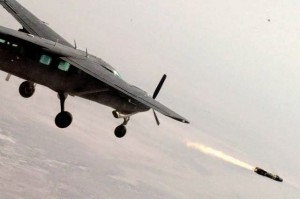US Air Strikes in Syria Proceeding as Expected: Civilian Deaths Documented, ISIS Recruitment Up
Last week, besides pointing out the obscene fact that the US Senate approved $500 million for the US to get more involved in the Syrian civil war on the same day the UN announced a $352 million funding shortfall for feeding civilian refugees of the war, I predicted that the “training” of Syrian rebels would fail just like training in Iraq and Afghanistan but civilian deaths from the US air strikes and at the hands of the rebels would greatly aid recruiting in extremist groups like ISIS.
It turns out that ISIS recruiting shot up even on Obama’s announcement of the US effort:
At least 162 people joined the radical al Qaeda offshoot in northeast and eastern Aleppo in the week after Obama’s speech on Sept. 10, said the Britain-based Syrian Observatory for Human Rights, which gathers information on the conflict.
Islamic State has put particular pressure on rival insurgent groups in this part of Aleppo.
An additional 73 men had joined the group on Sept. 23 and 24 in the northeast Aleppo countryside since the start of the strikes, the Observatory said, bringing the total number since Sept. 10 to at least 235.
“This means these people are not scared. Even if there are air strikes, they still join,” said Rami Abdelrahman, who runs the Observatory.
And, just as could be expected from the “pinpoint” US air strikes, for which we have virtually no on-site intelligence to guide the strikes (other than reconnaissance flights by drones), we are now getting reports of civilian casualties. From Reuters yesterday:
U.S.-led air strikes hit grain silos and other targets in Islamic State-controlled territory in northern and eastern Syria overnight, killing civilians and militants, a group monitoring the war said on Monday.
The Britain-based Syrian Observatory for Human Rights said the strikes hit mills and grain storage areas in the northern Syrian town of Manbij, in an area controlled by Islamic State, killing at least two civilian workers.
Isn’t that nice? Our intelligence-gathering for the air strikes can’t distinguish ISIS bases from silos used to distribute grain to starving civilians. How many new recruits will ISIS get from families whose only food supply was bombed in that strike or whose family members were killed by it?
Of course, the US military refuses to believe any evidence that it could possibly make a mistake. From the same Reuters story:
The U.S. military said on Monday an American air strike overnight targeted Islamic State vehicles in a staging area adjacent to a grain storage facility near Manbij, and added it had no evidence so far of civilian casualties.
“We are aware of media reports alleging civilian casualties, but have no evidence to corroborate these claims,” said Colonel Patrick Ryder, a spokesman at the U.S. military’s Central Command. He promised that the military would look into the report further, saying it took such matters seriously.
You betcha. I’m sure Central Command will get right on that investigation of how it killed silo workers (and see below for the military admitting that it can’t properly evaluate the effects of strikes). Just as soon as they get the next fifty or so new targets for air strikes put on their targeting lists.
Sadly, this strike on the silos is not the only instance of civilian deaths from the US strikes. The Daily Mail has more information from the Syrian Observatory for Human Rights about yesterday’s strike and the overall civilian death toll from all strikes:
Mr Abdulrahman, said today: ‘These were the workers at the silos. They provide food for the people.’ The airstrikes ‘destroyed the food that was stored there’.
The group says at least 19 civilians have been killed so far in coalition airstrikes.
And, of course, the US has not acknowledged any of the previous civilian casualties, either. All they will say is that the evidence is “inconclusive”:
Earlier Monday, the Pentagon admitted that some assessments of civilian casualties were “inconclusive” since the U.S. was only using drones to assess the results of strikes from the air.
“The evidence is going to be inconclusive often. Remember we’re using [intelligence, surveillance and reconnaissance] to determine the battle damage assessment,” Pentagon spokesman Army Col. Steve Warren said Monday.
A defense official told The Hill earlier this month that accurate assessments of damage from strikes are impossible without U.S. forces on the ground to exploit the attack sites, since Iraqi and Syrian partners did not have the capability.
Gosh, I don’t understand how we can have sufficient analytical ability to select targets but insufficient ability to assess the results of strikes on those targets. Sounds to me like the military is just bombing Syria for shits and giggles.
And to help contractors sell more bombs.

